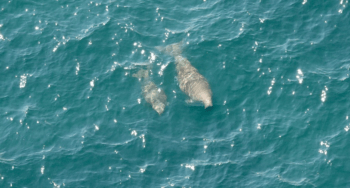Marine Dugongs May Be Long Gone If Not Protected

It’s got a funny name and it looks even funnier. Dugongs will never win any beauty contests, and few people probably know what they are. But a Texas A&M University at Galveston researcher is trying to find ways to save the bulky underwater elephant-like creatures from being just another marine species that has gone extinct.
Christopher Marshall, associate professor of marine biology at Texas A&M at Galveston, has been studying dugongs, or sea cows, especially those concentrated around the Middle East nation of Qatar for several years. The Arabian Gulf is home to the second largest population of dugongs in the world — at least 6,000 of them — and is the most important population in the western part of their range. Marshall and his colleagues have re-discovered the largest single herd of dugongs in the world — over 500 of them that may have been the inspiration for mermaids by ancient sailors.
For starters, dugongs are distant cousins of manatees, but creatures are more closely related to elephants than other marine mammals. They can be as long as 9 feet in length, weigh almost 900 pounds and live up to 70 years as they happily munch on underwater seagrasses. They are the only marine mammal that is strictly a herbivore, meaning they eat vegetation only, but they can consume as much 80 pounds of seagrass a day.
They are not found in the United States, but mainly in Australia, areas of the Indian Ocean, East Africa, the Philippines and several other locations.
“We have learned in recent years that their numbers in the Arabian Gulf are in a steady decline for several reasons,” Marshall explains.
“To begin with, they reproduce at an extremely slow rate – females give birth only every 2.5 years or so. But their biggest enemies are fishermen. They get caught up in fishing nets accidentally – what is called ‘by-catch’ – and in many areas, you can see them dead as they have washed up on shore with nets still tangled around their bodies.”
Dugongs – the name comes from a Malaysian word meaning “lady of the sea” and they are sometimes called sea cows and sea pigs – split from the elephant family tree about 60 million years ago and moved into coastal marshes and wetlands. But unlike manatees, dugongs never enter fresh water.
They are endangered worldwide but are still hunted in some areas for their meat and the oil contained in their large bodies.
“Reducing the by-catch numbers and protecting their habitat — sea grass meadows — are our best options for keeping their numbers up,” Marshall adds.
“We have established a marine stranding network in Qatar to help monitor the status of dugongs. We still don’t have accurate figures of how many there are left, but we know for sure their numbers are down in this region. We believe that the by-catch observed in Qatar is not sustainable and will reduce the population.
“These are special marine mammals that are unlike any others in the world,” he notes. “We have to find ways to protect them.”
Media contact: Keith Randall, Texas A&M News & Information Services.





